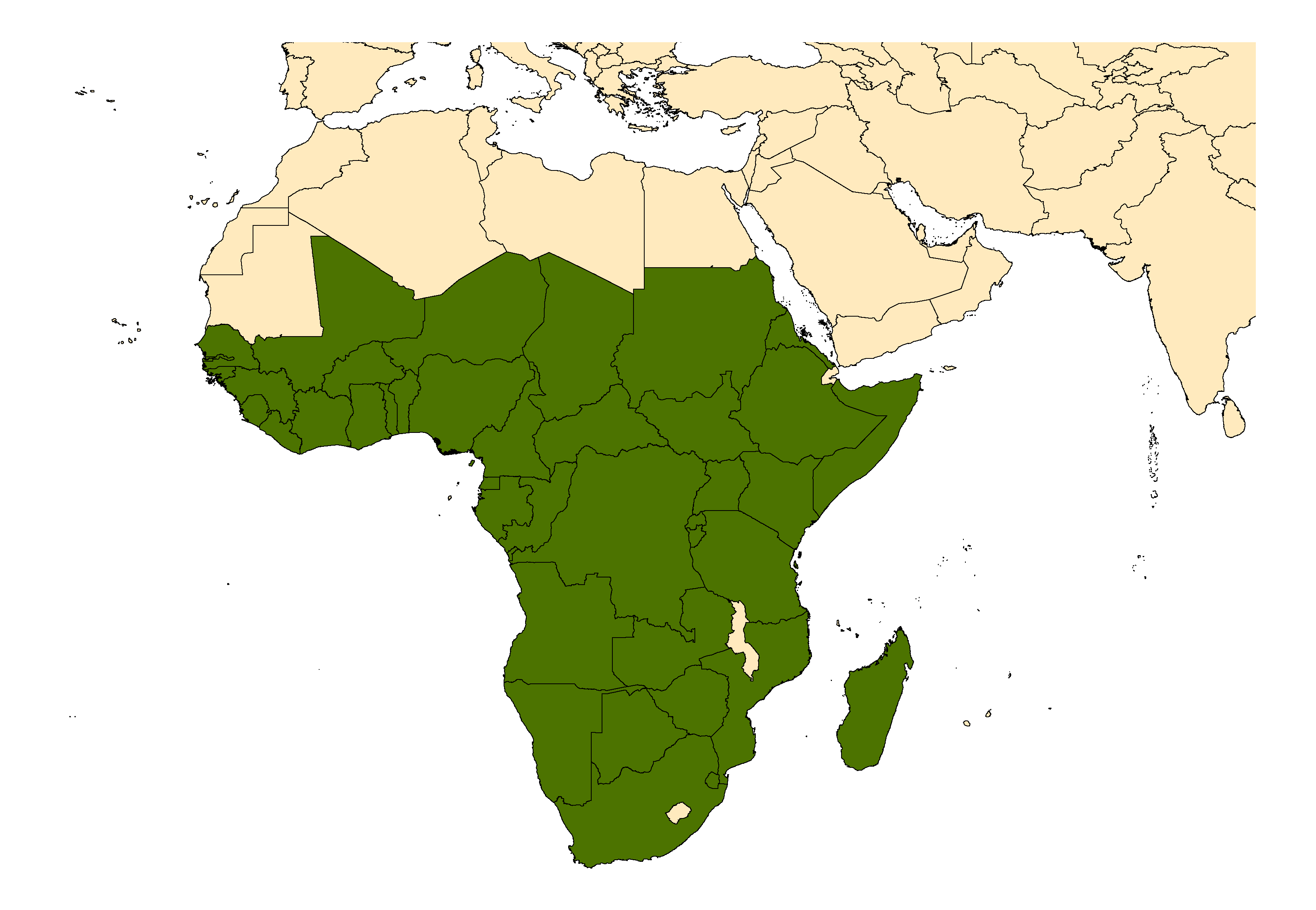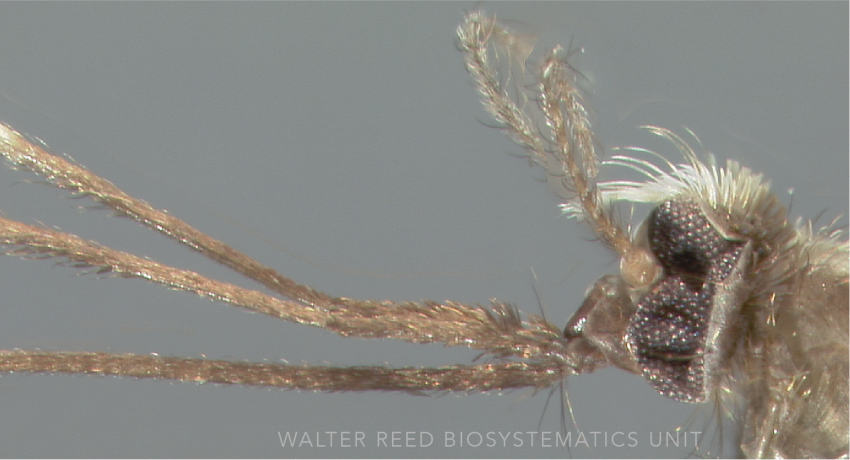AFROTROPICAL REGION
Etymology: Nile River, Sudan (L)
Anopheles nili is the nominotypical member of the Nili Complex (Neomyzomyia Series), with two valid synonyms—unicolor Grünberg from Ghana, and nigra Christophers from Sudan. Other members of the Complex include An. carnevalei Brunhes, Le Goff & Geoffroy, An. ovengensis Awono-Ambene, Kengne, Simard, Antonio-Nkondjio & Fontenille, and An. somalicus Rivola & Holstein. While these four species can be differentiated on subtle morphological characters of the adults and larvae, they are routinely differentiated using molecular techniques. Anopheles nili s.s. are found across almost all forest and humid savannah zones in sub-Saharan Africa, including Madagascar. Anopheles somalicus has been reported from Burkina Faso, Cameroon, Cote d'Ivoire, Guinea, Mali, Sierra Leone, and Somalia, An. carnevalei appears restricted to West Africa (Cameroon, Côte d’Ivoire, Equatorial Guinea), and An. ovengensis has only been recorded in Cameroon. Recent microsatellite analyses suggest that An. nili from Cameroon may comprise additional cryptic diversity.
Type locality: Jebel Akmet-Aga on the White Nile, Sudan
Type depository: Natural History Museum, London, England, United Kingdom (NHMUK)
DIAGNOSTIC CHARACTERS (Click photos to view; mouse over and click large photo to zoom in.)
ADULT (illustrated): Head: MPlp dark except for pale apex. Wing: Preapical dark spot on vein R1 without pale interruption; vein M3+4 with a single pale spot; preapical pale spot subequal to length of apical dark spot. Pale fringe spot present at end of vein M3+4 (nili and somalicus) or pale fringe present at end of M3+4 (ovengensis and carnevalei).
LARVA (not illustrated): Head: Seta 2-C strongly branched apically, branches mostly mesal; seta 3-C 0.5 or more length of 2-C. Thorax: Seta 1-P flattened, inserted on distinct basal tubercle; setae 9,10-M single. Abdominal segments: All palmate setae with long filaments, extending to an acute point.
TAXONOMIC KEYS
Gillies & Coetzee 1987
![]()
WRBU - Anopheles - Afrotropical Region - Larva
![]()
WRBU - Genera - Global - Adult
![]()
WRBU - Genera - Global - Larva
![]()
WRBU - Genera - Afrotropical - Adult
![]()
WRBU - Genera - Afrotropical - Larva
Exemplar DNA sequences
An. nili ITS2: AJ429048
An. carnevalei ITS2: AJ429050
An. ovengensis ITS2: AJ429049
An. somalicus ITS2: AJ438689.
BIONOMICS
Immatures
Immatures An. nili are found amongst vegetation and debris collected at the edge of sunlit, fast-flowing rivers. In contrast, immatures of An. carnevalei and An. ovengensis, are typically found amongst water lettuce (Pistia spp.) in the cooler waters of heavily-shaded, slow moving rivers in deep forest environs.
Adults
As a forest-savannah transition species, An. nili habitats closely follow river valleys, degraded forest, agricultural clearings, villages and even city margins, increasing its impact in human malaria transmission. Infection rates of 1-3% are typical for An. nili. Forest An. nili s.s. are endophilic and anthropophilic, whereas the savannah populations appear exophilic. Anopheles carnevalei and An. ovengensis are found deeper into the forest. Anopheles nili, An. carnevalei and An. ovengensis are all highly anthropophilic and are involved in the transmission of human malarias. Biting rates of 50–300 bites per human per night have been recorded for An. ovengensis along river habitats in Equatorial Guinea, and Plasmodium infection rates of 0.4 to 4.4% have been reported in Cameroon and Equatorial Guinea. Anopheles carnevalei feeds throughout the night, mainly on animals but can be found biting humans outdoors, particularly at outdoor riverine bathing sites near dusk. By contrast, An. somalicus is intensely zoophilic.
DISTRIBUTION NOTES
Angola, Benin, Botswana, Burkina Faso, Burundi, Cameroon, Central African Republic, Chad, Congo, Côte d'Ivoire, Democratic Republic of the Congo, Eswatini, Ethiopia, Equatorial Guinea, Eritrea, Gabon, Gambia, Ghana, Guinea, Guinea Bissau, Kenya, Liberia, Madagascar (includes Glorioso & Juan De Nova Is), Mali, Mozambique, Namibia, Niger, Nigeria, Republic of South Africa, Rwanda, Senegal, Seychelles, Sierra Leone, Somalia, South Sudan, Sudan, Tanzania, Togo, Uganda, Zambia, Zimbabwe.

WRBU VECTOR HAZARD REPORTS
View other WRBU Vector Hazard Reports
Available GIS Models
IMPORTANT REFERENCES (full citations below)
Theobald 1904b: 66 (F*; Myzomyia)
Macfie & Ingram 1922 (F*)
Evans 1938: 137 (M, F*, P*, L*, E*)
Hamon 1954a: 583 (L*)
Lewis 1956a: 477 (L)
Peters 1956: 531 (taxonomy)
Gillies & De Meillon 1968: 83 (M*, F*, P*, L*, E*)
Ribeiro & da Cunha Ramos 1975: 16 (distribution)
Gillies & Coetzee 1987 (F*, L*; key, bionomics)
Kengne et al. 2003 (molecular taxonomy, sensu lato)
Awono-Ambene et al. 2006 (molecular taxonomy; sensu lato)
Antonio-Nkondjio et al. 2009a (phylogenetics; as moucheti; Nili Complex)
Antonio-Nkondjio et al. 2009b (L bionomics)
Sinka et al. 2010: 117 (bionomics review, distribution, niche model; Nili Complex)
Antonio-Nkondjio & Simard 2013 (bionomics, molecular taxonomy; sensu lato, review)
Ndo et al. 2013 (sensu lato; molecular taxonomy)
Antonio-Nkondjio & Simard 2013 (molecular taxonomy; sensu lato)
Kyalo et al. 2017 (distribution; sub-Saharan Africa)
CURRENT SYNONYMS
syn. unicolor Grünberg
1905: 379 (F*; Myzomyia). Type locality: Kete Kratje, Togo [Ghana] (ZM).
syn. nigra Christophers
1924a: 45 (A; funesta variety). Type locality: Mid Sobal, Sudan (NHMUK).
CITED REFERENCES
Antonio-Nkondjio, C., & Simard, F. (2013). Highlights on Anopheles nili and Anopheles moucheti, malaria vectors in Africa. In S. Manguin (Ed.), Anopheles mosquitoes: new insights into malaria vectors (pp. 221–238). Janeza Trdine 9, 51000 Rijeka, Croatia: InTech.
Antonio-Nkondjio, C., Ndo, C., Costantini, C., Awono-Ambene, P., Fontenille, D., & Simard, F. (2009a). Distribution and larval habitat characterization of Anopheles moucheti, Anopheles nili, and other malaria vectors in river networks of southern Cameroon. Acta Tropica, 112(3), 270–276.
Antonio-Nkondjio, C. Ndo, C., Costantini, C., Awono-Ambene, P., Fontenille, D. & F. Simard. (2009b). Distribution and larval habitat characterization of Anopheles moucheti, Anopheles nili, and other malaria vectors in river networks of southern Cameroon. Acta Tropica, 112(3), 270–276.
Awono-Ambene, H. P., Simard, F., Antonio-Nkondjio, C., Cohuet, A., Kengne, P., & Fontenille, D. (2006). Multilocus enzyme electrophoresis supports speciation within the Anopheles nili group of malaria vectors in Cameroon. American Journal of Tropical Medicine and Hygiene, 75(4), 656–658.
Christophers, S.R. (1924a). Provisional list and reference catalogue of the Anophelini. Indian Medical Research Memoirs, 3, 1–105.
Evans, A.M. (1938). Mosquitoes of the Ethiopian Region. II. Anophelini adults and early stages. London: British Museum (Natural History).
Gillies, M.T., & Coetzee, M. (1987). A supplement to the Anophelinae of Africa south of the Sahara (Afrotropical Region). Publications of the South African Institute for Medical Research, 55, 1–143.
Gillies, M.T., & de Meillon, B. (1968). The Anophelinae of Africa, south of the Sahara (Ethiopian zoogeographical region). Publications of the South African Institute for Medical Research, 54, 1–343.
Grünberg, K. (1905). Zur Kenntnis der Culicidenfauna von Kamerun und Togo. Zoologischer Anzeiger, 29, 377–390.
Hamon, J. (1954a). Contribution a l'étude des Culicides de la region de Bobo Dioulasso (Haute-Volta). Annales de Parasitologie Humaine et Comparee, 29(5–6), 573–587.
Hay, S.I., Sinka, M.E., Okara, R.M., Kabaria, C.W., Mbithi, P.M., Tago, C.C., …Godfray, H.C.J. (2010). Developing global maps of the dominant Anopheles vectors of human malaria. PLoS Medicine, 7(2): e1000209.
Kengne, P., Awono-Ambene, P., Antonio-Nkondjio, C., Simard, F., & Fontenille, D. (2003). Molecular identification of the Anopheles nili group of African malaria vectors. Medical and Veterinary Entomology, 17(1), 67–74.
Kyalo, D., Amratia, P., Mundia, C.W., Mbogo, C.M., Coetzee, M., & Snow, R.W. (2017). A geo-coded inventory of anophelines in the Afrotropical Region south of the Sahara: 1898–2016. Wellcome Open Research, 2, 57.
Macfie, J.W.S., & Ingram, A. (1922). On the genital armature of the female mosquito. Annals of Tropical Medicine and Parasitology, 16, 157–188.
Ndo, C., Simard, F., Kengne, P., Awono-Ambene, P., Morlais, I., Sharakhov, I., . . . Antonio-Nkondjio, C. (2013). Cryptic genetic diversity within the Anopheles nili group of malaria vectors in the Equatorial forest area of Cameroon (Central Africa). PLoS ONE, 8(3), e58862.
Peters, W. (1956). The mosquitos of Liberia (Diptera: Culicidae), a general survey. Bulletin of Entomological Research, 47, 525–551.
Ribeiro, H., & da Cunha Ramos, H. (1975). Research on the mosquitoes of Angola. VI. The genus Anopheles Meigen 1818 (Diptera. Culicidae). Check-list with new records, keys to the females and larvae, distribution and bioecological notes. García de Orta (Ser Zool), 4(1), 1–40.
Sinka, M.E., Bangs, M.J., Manguin, S., Coetzee, M., Mbogo, C.M., Hemingway, J., ...Hay, S.I. (2010a). The dominant Anopheles vectors of human malaria in Africa, Europe and the Middle East: Occurrence, data, distribution maps and bionomic précis. Parasites & Vectors, 3(117), 1–34.
Theobald, F.V. (1904b). The mosquitoes of Egypt, the Sudan, and Abyssinia. Khartoum Report Wellcome Research Lab, 62–83.
CITE THIS PAGE
Walter Reed Biosystematics Unit (Year). Anopheles nili species page. Walter Reed Biosystematics Unit Website, http://wrbu.si.edu/vectorspecies/mosquitoes/nili, accessed on [date (e.g. 03 February 2020) when you last viewed the site].









































































































































































